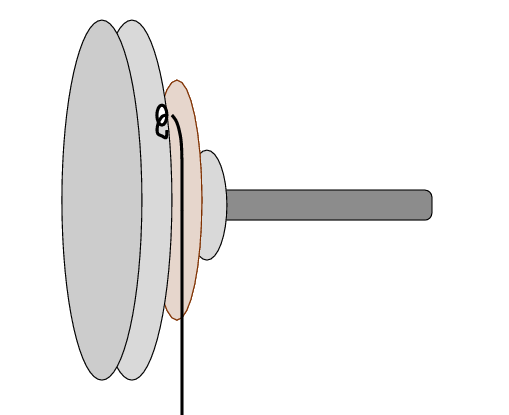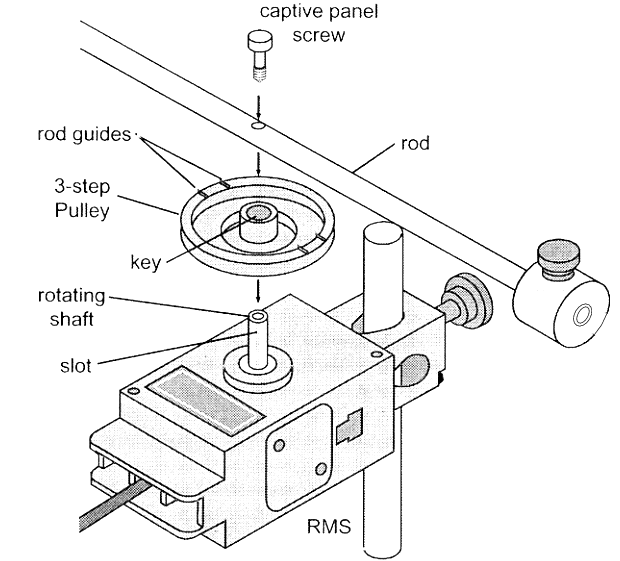
Today you will examine the moment of inertia of a pair of brass weights.
Your job is to calculate the moment of inertia from theory, and also to determine the moment of inertia from an experiment in which these objects are spun around and around. The goal in the end is to see if the theoretical and experimental values agree to within their uncertainties.
Each group will hand in a report due at the end of today's class.
Tips for success:
Step 1:
Attach the Rotational Motion Sensor (RMS) with its 3-step pulley near the top of an aluminum rod, far above the level of the tabletop. Clamp the Super Pulley onto the RMS, on the side pointing away from the table.You need to wrap a piece of black thread around the MIDDLE step of the 3-step pulley. Tie the thread in a knot anchored in the hole of the middle or largest step.

This would be a good time to measure the radius of this middle step. Use the vernier calipers with digital readout.
To the other end of the thread, tie a 5-gram plastic hanger from the blue mass set. Do NOT place any additional mass on the hanger.
Step 2: measure time to fall when rod rotates alone
Attach the rod -- without the brass weights -- to the 3-step pulley. The rod should sit within a set of guides on opposite sides of the 3-step pulley.

These measurements will allow you to determine the moment of inertia of (the RMS apparatus plus the rod).
Step 3: measure time to fall when rod rotates with weights
Attach the brass weights to each end of the rod, so that the outer face of each weight is flush with the outer end of the rod.

These measurements will allow you to determine the moment of inertia of (the RMS apparatus plus the rod plus weights).
At this point, show your measurements to an instructor. Do not move forward until your values are checked and approved.
Place the two brass weights at the very ends of the rod. Measure the distance of each weight from the center of the rod, and the mass of each weight. Calculate the moment of inertia of the two brass weights alone (ignoring the rod's contribution), and the uncertainty in this moment of inertia.
If you know the mass of the hanger, and its acceleration, you can compute the tension T in the string; it will NOT be (mass) * (g), but something slightly different. Read this if you need a hint. Find the tension, and its uncertainty.
The thread pulls with this tension at the rim of the middle step of the 3-step pulley. Compute the torque exerted by the string around the axis of the 3-step pulley, and its uncertainty.
You can turn the linear acceleration of the hanger into an angular accelertion of the 3-step pulley. Do so. Determine the uncertainty in this angular acceleration, too.
Now, with both torque on the apparatus, and angular acceleration of the apparatus, you can for each case compute a moment of inertia -- and uncertainty. Do so.
We are interested in the moment of inertia of the BRASS WEIGHTS ONLY.
I(weights plus rod) = I(weights only) + I(rod only)
You have enough information now to figure out this quantity and its associated uncertainty. Do so.
Does the moment of inertia from theory agree with the moment of inertia you measured in the experiment? Do they agree within the uncertainties? Explain. Be quantitative.